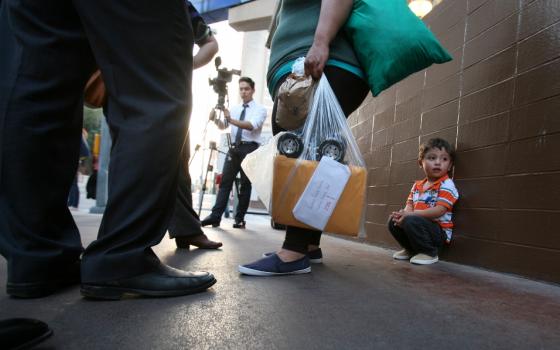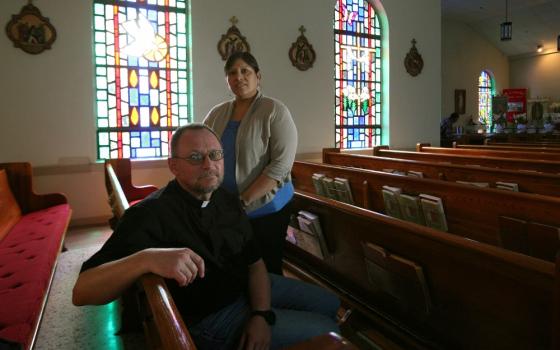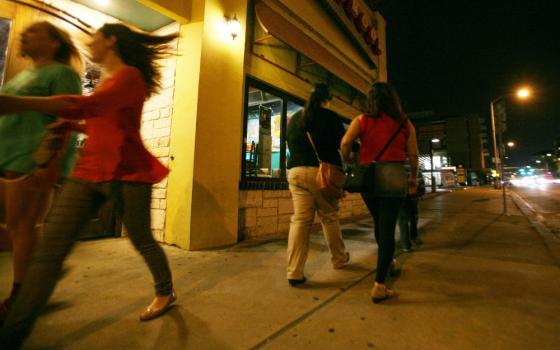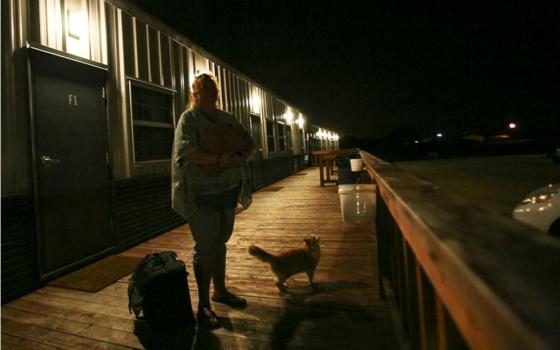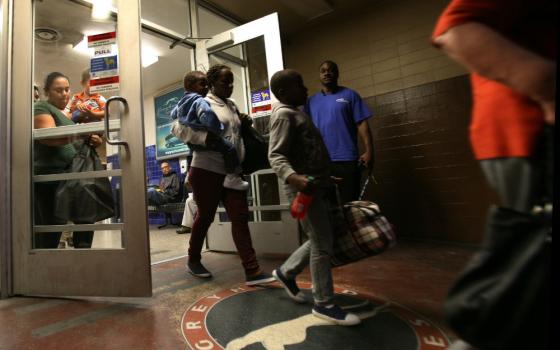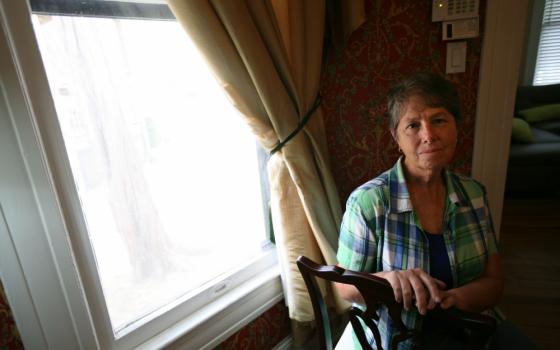For more background information about U.S. immigration, refugee and detention policy and practices, see 'They feel besieged' - Immigration update by Dan Stockman
The wake-up calls were abrupt and loud – guards pounding on doors at 5 a.m. – and then came shouts and the crying.
“The children wake up crying, screaming – the children because they knock too hard on the door,” said Edith Osorto, an immigrant from Honduras, describing a typical morning at the Karnes County Residential Center. And if the women didn’t get up, “They would enter and yell at us to get up. They would yell, ‘Ladies, get up! Delinquent ladies!’”
Some 183 women and children seeking asylum are held at Karnes, one of two family detention centers in south Texas operated by companies under contracts with Immigration and Customs Enforcement, known as ICE. Their plight is drawing increasing attention, fueled on the inside by a hunger strike and fast, and, on the outside, by legal jockeying and a recent visit by the head of ICE.
At the heart of the matter are complaints of lengthy stays in prison-like conditions, as well as a question repeatedly posed by activists, attorneys and faith-based organizations: Why are women and children being detained in centers run by for-profit corporations that specialize in the corrections industry?
Family detention had all but ended in 2009 but was reinstated by the Obama administration after the influx of women and children fleeing Central America last summer.
“They’re putting these kids in these lock-down facilities, unlicensed facilities – they are run by correctional staff,” said Ranjana Natarajan, a clinical professor and director of the Civil Rights Clinic at the School of Law at the University of Texas at Austin. “They are not licensed by the state of Texas to work in child care. In other words, none of the staff are trained to work in child care.”
Five Central American women who had been held at Karnes, including one who is still there, recently spoke with Global Sisters Report. All had stories to tell of violence or the threat of the violence that led them to flee their homes and of being confined in a place where they didn’t understand the rules or why they and their children were being treated so harshly.
Their stories were very similar, even though they had been in Karnes at different times. Among their complaints: being served food that was poorly cooked and at times spoiled; being yelled at by guards and staff and being written up for minor infractions committed by them or their children. Some described a culture of intimidation and fear from officials whom they said threatened to report infractions to immigration judges hearing their asylum cases.
“It’s a tense atmosphere because you feel like you’re in prison,” Kenia Galeano said outside the San Antonio Greyhound bus station on April 9. A few hours earlier she and her 2-year-old son, Alejandro Galeano, had been released on bond after five months at Karnes.
In response to questions about the allegations, ICE, which oversees operation of the family detention center, issued a statement: “Family residential centers are an effective and humane alternative for maintaining family unity as families go through immigration proceedings or await return to their home countries. ICE ensures that these residential centers operate in an open environment, which includes medical care, play rooms, social workers, educational services, and access to legal counsel.”
Another statement issued after ICE Director Sarah Saldaña’s visit April 17 described it as “a long-planned tour” in which Saldaña met “informally with residents and staff.”
The statement said, “Director Saldaña has every confidence in the staff and contractors at the Karnes facility to maintain a healthy and safe environment for residents in which issues and concerns are addressed quickly and appropriately as they arise.”
______
Karnes County Residential Center sits 55 miles southeast of San Antonio down U.S. Highway 181, a rural route dotted with wildflowers. Various signs greet visitors along several highways leading into town: “Karnes City, City Limit, pop. 3,042.” In the Stripes gas station, workers in dusty coveralls line up to pay for energy drinks and sodas. The oil-based economy is still humming.
At a glance, the center resembles a strip shopping center. Its beige exterior accented by a pastel blue entrance could easily be mistaken for a mall. Surrounding the structure is vast pastureland where several oil pumpjacks appear to graze. The GEO Group, Inc., a private prison corporation, operated it as a detention center for men until it was converted to house families last summer. Inside, a school, playground, library, medical clinic and hair salon surround a courtyard resembling a roadside motel. Freshly painted murals depict smiling animals, butterflies and palm trees on walls throughout the center.
But it wasn’t the facilities that the women complained about, it was a regimented life they said was too hard on their kids. Children had to be at their mother’s sides at all times, they said. Lights stayed on all night, though were dimmed at bedtime. Wake-up times, as early as 5 or 6 a.m., were mandatory, and head counts or “check-ins” were strictly enforced. Payment for voluntary work details averaged around $1 an hour
To comply with check-in, the mothers said they and their children had to present themselves in the center’s “day room” at 7:30 a.m., 4 p.m. and 8 p.m. An official would note their ID and mark their attendance on a sheet of paper. If their children were napping, they had to wake them up and appear.
“Many officials would yell, ‘Why didn’t you go to check-in?’ Galeano, a mother from Honduras, said. “And they filed a report on many companions because they didn’t go to check-in, because their kids were asleep and they forgot to go, and they reprimanded them and filed a report.”
While children were allowed to run outside, Galeano said they had to stay within three meters of their mother’s reach. If not, staffers would report them via two-way radio.
Osorto, who complained about the loud wake-up calls, said “no distance” was allowed between mothers and young children. “When you go to the bathroom, you have to take them in with you,” she said. If a staff member walked in while she was in the bathroom without her child, they would “reprimand” her or threaten to file a “report.”
Osorto said she saw one mother get written up when her daughter vomited on the floor and she rushed her back to her room. “This man went after her and he asked her for her I.D.,” Osorto said. When the woman asked the worker to wait briefly because she was helping her daughter, he told her he was going to file a report because the mother needed to be “more mindful” of her child.
The women said they were told the reports could be used as evidence in court proceedings over asylum.
“They tell you ‘I’m going to file a report,’ as if to intimidate you,” Osorto said. “This will hurt you,’ they tell you, ‘This will hurt your chance to get out of here.’”
But Jonathan Ryan, an attorney and executive director of the Refugee and Immigration Center for Education and Legal Services, or RAICES, said that he had never seen a judge take into consideration any behavior from a detention center. ” RAICES provides legal services to immigrants in Texas at little or no cost.
“It’s a baseless threat and a very cruel threat, very effective,” Ryan said. “I’ve represented adult men in detention who have undergone exceptional amounts of discipline inside of facilities and they haven’t brought that into the courtroom. I’ve never heard of it being done.”
______
The bus station in San Antonio is a gathering place for immigrants who have just been freed. Dropped off by vans or buses, the former detainees aren’t hard to spot. They carry belongings in plastic bags – purple Catholic Charities bags from McAllen, Texas, white mesh bags from the center in Dilley, Texas, and clear bags from Karnes – according to Mohammad Abdollahi, a spokesperson for RAICES.
Volunteers like JoAnn Saldaña of the Interfaith Welcome Coalition, an organization that helps detainees after they are released, greets the arrivals by helping them buy bus tickets, giving them home-cooked food and keeping them company.
“You can see they’re afraid, but once you introduce yourself and tell them you’re with the iglesia [church], they relax a bit and allow you to approach them and talk to them,” Saldaña said. “It is such a blessing to be there and they’re so grateful.”
At the station, Galeano said she could finally speak freely without worrying about phone calls or emails being monitored. She described how “visitantes de Washington” or Washington visitors – two ICE officials, attorneys and a human rights representative – questioned her the day before about conditions and her treatment by staff. “Now they know everything that in reality happens at the center,” she said then.
She and other mothers described rules at Karnes that they said weren’t realistic for children.
“The kids are playing, the kids are forbidden from screaming, from running in the place,” Galeano said trying to corral her son, who savored his new-found freedom by wandering close to the street. “A child can’t play like a normal child; he can’t act like a normal child because it’s against the center’s rules.”
Most of the complaints by the five women who spoke to GSR in April were directed at the guards and staff of GEO Group. When asked about the allegations, Pablo Paez, vice president of corporate relations, declined an interview but issued a statement:
“The Karnes County Residential Center provides high quality care in a safe, clean, and family friendly environment and onsite U.S. Immigration and Customs Enforcement personnel provide direct oversight to ensure compliance with ICE's Family Residential Standards. Our company has consistently, strongly denied allegations to the contrary.”
In January an investigation by the inspector general of the Department of Homeland Security, of which ICE is a part, cleared the GEO Group staff of complaints of alleged sexual abuse and misconduct. “We found no evidence to substantiate the allegations and were unable to identify a victim or suspect in this matter,” the inspector general’s report said.
More recently two more sexual allegations were made. One is currently being investigated. “Every allegation of sexual assault is taken very seriously,” ICE said Thursday.
None of the women recently interviewed voiced any complaints that were sexual in nature, but they all described an atmosphere of humiliation and intimidation.
Attorney Linda Brandmiller, director of the Asociación de Servicios para el Inmigrante, Inc., said her clients voiced similar complaints about their treatment at Karnes. At one time she said she had around 80 clients who would fill the waiting room to capacity when she visited.
“They are met with contempt; they are yelled at,” Brandmiller said. “It’s a very demeaning relationship.”
“The majority treat people poorly,” said Loida Cortez, a mother from El Salvador who was released in September after 45 days in the detention facility. “You feel bad because you’re Latino or an immigrant and the humiliations that they give you there, are things you never forget.
“When we went to ask for diapers or wipes, they [workers] would practically throw them at you,” Cortez said. And, she added, at times she was told that there were none when she could see them clearly behind the counter.
Alejandra, a mother from El Salvador who asked that her real name not be used, described a similar experience. “There are women there who are deplorable at meal times when you pass by them, when they pass the plate of food to you, they practically shove the plate of food at you,” she said. But, she added that not all the workers were as disrespectful.
Yvonne Dilling, the director of Mission Education for the Maryknoll Fathers and Brothers in San Antonio also heard complaints from women she visited at Karnes. Having done pastoral work in El Salvador for years, she is occasionally contacted by family and friends to check on their loved ones in the facility.
One woman she visited was afraid to ask for shoes despite hers being too small. “I looked under the table at the woman and there are a pair of gym shoes that obviously her toes are crumpled,” Dilling said. “She bent the back down of the tennis shoe and made them into slip-ons in order to be comfortable.”
When asked why she didn’t ask for shoes, Dilling said the woman told her, “’I don’t trust that these little complaints won’t affect my case.’”
But while Dilling said she routinely heard complaints from women, she herself had never been mistreated. “I personally have never had any difficult conversation with any employee at GEO, ever, but I’m not in there asking for exceptions to military-style rules like you have to get up at 5 a.m.”
The local parish priest, the Rev. Stanley Marciniak, pastor of St. Cornelius Catholic Church, said he had not heard complaints about the workers at Karnes. “And my impression when I see the guards with the children or when we are celebrating Mass . . . they are very nice to them.”
But, his secretary, Rosie Arguellez, who accompanies him to the center every Tuesday, said contact with the women is restricted so they wouldn’t know if problems exist.
“When we trained there, we were specifically told we could not interact with them personally,” she said.
______
The quality of the food was a recurring complaint. “Sometimes they serve food that is past its expiration date,” Osorto said, describing a plate of spaghetti mixed with meat, corn and peas. “That meat stunk.”
The mothers offered similar reports: the rice and beans were regularly undercooked, while the bread was often hard. “The rice, they add so much pepper it looks black, and it’s spicy,” Alejandra said.
When Saldaña, of the Interfaith Welcome Coalition noticed that released detainees arrived hungry to the bus station, she began bringing home-cooked food to swap for the sandwiches they carried. “In Karnes they just get bologna sandwiches, nasty bologna, nothing else, bologna, government cheese on white bread,” Saldaña said.
Because of the food, the women said their children refused to eat and wouldn’t drink the water they claimed had a sulphuric taste. Some, they said, vomited when their mothers tried to force-feed them to keep their weight up. Alejandra said her son, Mario, 8, weighed 60 pounds when he entered Karnes and lost 20 pounds by the time he left. Detainees were weighed regularly by medical staff, according to the mothers.
“They would weigh him and instead of saying that he was losing weight, they would say he was gaining,” Alejandra said. “When he got out you could count all his ribs and his head was gaunt.”
Delmy Piñeda Cruz found herself at the center of a firestorm when she and other women held a hunger strike during Holy Week. Piñeda said she was isolated in a dark room in the medical clinic with her 11 year-old son, Alexis Lemus. “They accused me of being the leader of the group,” Piñeda said, “and that’s why they took me to that room as punishment.”
She said the room had one bed, a toilet, a camera and a sink but no soap. To drink she and her son had to cup their hands and scoop up water. “I felt bad using the toilet because my son is big. It was awkward – believe me it was horrible.” She and her son were let out the following day.
Activists likened Piñeda’s isolation to solitary confinement, but ICE disagreed. “ICE residential centers do not have solitary confinement areas,” they wrote in a statement, and denied the strike actually happened.
“We can assure you there has not been a hunger strike,” said an ICE official during a media tour of the facility on Thursday. ICE said a hunger strike constitutes nine consecutive missed meals and residents’ intake is monitored for their health and well-being.
Galeano thinks that the reason ICE questioned the strike was a misunderstanding because mothers bought food from the commissary for their children, but they themselves did not eat. “It happened; they know it happened,” Galeano said.
Although the first strike ended April 3, a second fast by 10 women began April 14. This time they are eating one meal per day, Abdollahi, the RAICES spokesperson, said. However, ICE said Thursday, “every resident is documented as eating here, except for one this morning.”
Regarding the weight loss reported by some residents, ICE said healthy snacks are available and everyone is allowed to go back for seconds in the dining hall. “It’s all you can eat here at the facility during the hours that it’s open.”
As for the complaints that mothers have to keep children close by at all times, ICE said they wanted to make sure children were being supervised by their mothers.
During the media tour April 22 ICE showed some of the improvements that came about in answer to complaints, such as making food less spicy and providing filtered water at one of the water fountains in the day room. Three more are planned.
But Brandmiller was skeptical about the media tour. “They stock all the refrigerators, they serve different food,” adding, “And the minute the [visitors] are gone, it’s not their reality.”
While on the tour, one of the women in detention tried to approach the media but was escorted away. No one was allowed to interview or talk to women at the center.
______
The voices of attorneys and activists calling for an end to family detention have grown louder.
Particular criticism is directed at for-profit detention contractors. “They are contracted by the United States government to run this detention center,” said Dilling. “They’re paid on a per-diem basis, and they’re for profit,” she said. “And what they don’t spend on clothing, food and medicine is their profit.”
Attorneys like Natarajan, Brandmiller and Ryan believe the practice needs to end entirely. Natarajan said it violates a 1997 settlement, called the Flores Agreement that called for the U.S. government to stop placing undocumented minors in lock-down centers and release them to family or friends if available.
But the large influx of Central American children that overwhelmed immigration officials last summer led to changes in the policy. U.S. attorneys filed a motion in February with the U.S. District Court in the Central District of California to amend the settlement. They cited several reasons such as the large the influx of immigrants that made it “impossible to mandate full and strict compliance with all terms of the nearly two decades-old agreement while expecting DHS to fulfill its core function of protecting the public safety and enforcing U.S. immigration laws.”
Natarajan and several attorneys countered by filing a motion to enforce the 1997 settlement. That motion is scheduled to be argued April 24 in California. “There is no reason they couldn’t follow the settlement agreement just because the numbers have gone up,” she said. “There are no limitations in the settlement agreement.”
While activists, volunteers and attorneys fight to end family detention, the women grappled to understand why they were punished when they came here seeking refuge.
“Why do they treat us this way?” Piñeda asked. “We’re just mothers who came asking for help, asking for refuge for our children, too.”
Most of the mothers said they fled because of gang violence in El Salvador and Honduras. The U.S. Department of State website warns travelers that crime and violence levels in those countries “remain critically high.”
When gang members killed her son’s friend, tore up his Bible and threatened to kill him if he did not join them, Piñeda said she presented herself at the Texas border. “I need help,” she told an official, “Please help me.”
Her case, is a complicated one, because like some of the women in detention, she had previously been deported from the U.S. It is now on appeal.
As some of the women’s cases were denied and they waited on their appeal, most said they did not want to think about what would happen if they lost.
“I have great faith in the Lord,” Alejandra said, “because if he helped me get here, he has something big prepared for me and my son.
[Nuri Vallbona is a freelance documentary photojournalist who has focused most of her career on social justice projects such as modern-day slavery, inner-city poverty and crime. She worked for the Miami Herald from 1993 to 2008, has won a number of awards and is a former lecturer at the University of Texas and Texas Tech University.]
